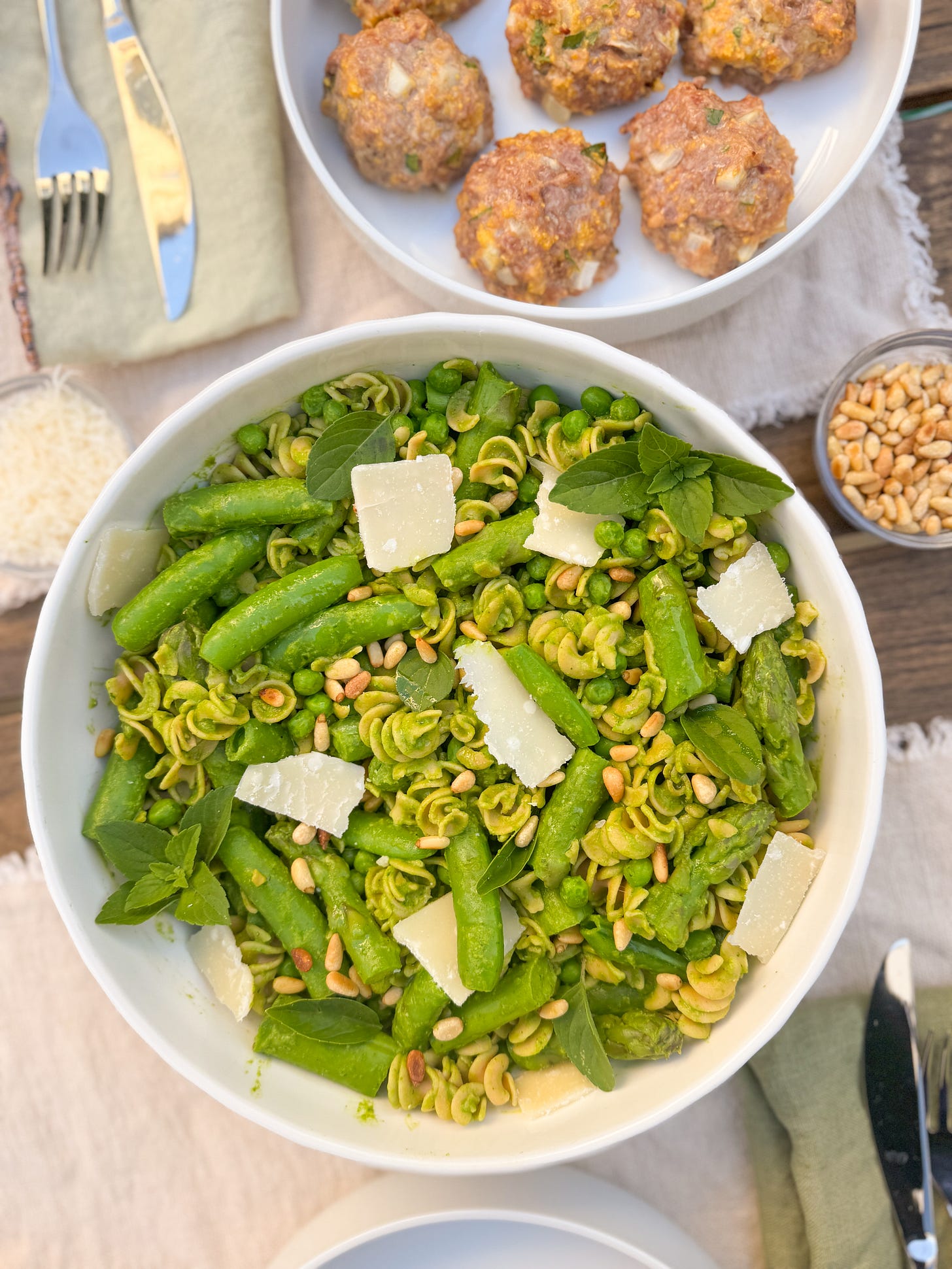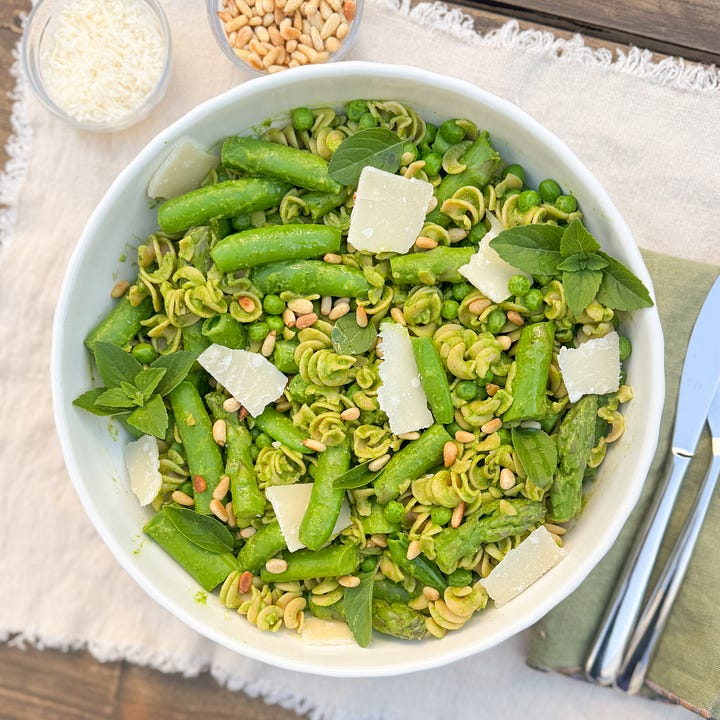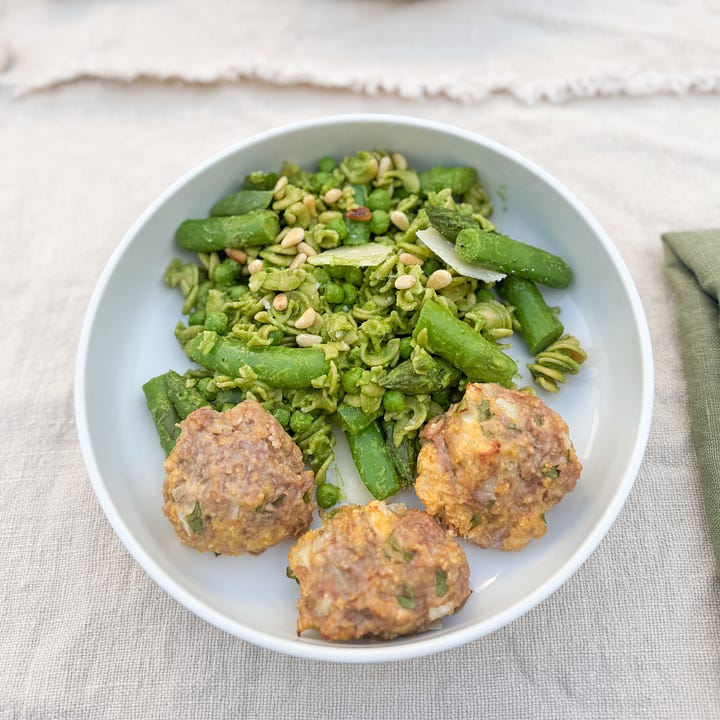Spring Green Pasta with Snap Peas, Asparagus and Peas
Plus where I buy my meat & fish (and what I look for)
Colorful chefs - happy Thursday 💚

Where I Buy My Meat & Fish (and What I Look For): Do you sometimes feel overwhelmed trying to buy the “right” meat? You’re not alone! A Color Club member asked where I buy my proteins and what I look for — especially when it comes to chicken — and it sparked me writing up a deep dive into sourcing quality animal protein. In this post, I’m breaking down what I’ve learned after years of reading, researching, testing, and most recently, working with the team at Lineage Provisions. I cover what labels like like grass-fed, organic, and sustainably farmed really mean, why “wild-caught” isn’t the whole story, and how I personally shop for red meat, poultry, and fish that’s better for my body — and the planet! I’m fired up!!!!!
Spring Green Pasta with Snap Peas, Asparagus and Peas: This is honestly everything I want in a weeknight dinner: quick, vibrant, packed with flavor, and comes together with just one pot and a blender. Serve it warm or cold, add your favorite protein, and you’ve got an easy, saucy meal!
I got this excellent question from a Color Club member earlier this week:
“Where do you buy your meat and what do you look for? What makes quality meat vs. not? I’m especially wondering about chicken!! I try to buy organic and healthy everything, but I struggle finding good sources for meat!!”
Girl, I feel you. I loved this question because it’s one I’ve been exploring for years. And while my approach is definitely more nuanced now than just “buy organic,” I’ve also come to appreciate how complex this world really is. Agriculture and food systems are full of trade-offs. It’s not black and white. “Grass-fed” is not standardized. “Organic” doesn’t always mean ethical. And “wild-caught” doesn’t always mean sustainable.
Through reading, research, and especially in the last few months working alongside the team at Lineage Provisions, I’ve developed a sourcing lens that prioritizes nutrient density, regenerative practices, and transparency — but I’m still learning! Here’s what sourcing looks like for me right now across beef, lamb, venison, chicken, and fish. As always, as I learn more, I’ll share with you all!
🥩 Red Meat
What I buy:
100% pastured, grass-fed and grass-finished beef from regenerative farms, ideally local or ones ones I can vet or learn more about.
Why:
Not all grass-fed beef is equal. Many brands label meat “grass-fed” even if the animals are finished on grain in feedlots (which drives down nutrient density and animal welfare). Even “grass-finished” doesn’t always mean high quality. At Lineage, the team found that some “grass-fed” farms wouldn’t even let us visit, despite saying all the right things on paper. That makes you wonder what exactly their “grass-fed” practices look like (i.e., are they dumping grass on cows smashed together in small feedlots every day, or are the cows actually pastured and chewing on grass all day?)
Why is grass-fed the goal? It’s higher in anti-inflammatory fats (higher in omega-3 fatty acids, more balanced ratio of omega-6 to omega-3s), richer in antioxidants and vitamins, better aligned with how ruminant animals like cows are designed to eat, and often raised on healthier soil which is better for the earth. Ideally, cows are both grass-fed and pastured, meaning rotationally grazing in open pastures. Generally, regenerative farming mean the cows are on pastures most of their lives.
The next question I often get is “how exactly is regenerative meat better for the earth?”
Short answer: Regenerative meat, when raised through practices like rotational grazing and holistic land management, can actually have positive environmental impacts — unlike conventional feedlot systems. When ruminants like cows are moved across pasture in a way that mimics natural herd behavior, their hooves aerate the soil, their manure fertilizes it, and the grasslands they graze on grow back stronger and more diverse. This process actually pulls carbon from the atmosphere and stores it in the soil — a natural form of carbon sequestration.
Studies have shown that regenerative practices can sequester between 2.29 and 3.6 tons of carbon per hectare (!!!) annually, according to Force of Nature Meats and Civil Eats.
Regenerative farms also reduce erosion, improve water retention, and restore native ecosystems. So, when done right, raising red meat doesn’t just avoid harm — it actively helps heal the land!
One of the best things you can do is find a local farm with transparent grass-fed practices. That way, your meat isn’t traveling thousands of miles, and you can actually talk to the people raising your food! But when that’s not possible, I still love supporting brands doing it right.
My go-tos:
Primal Pastures – Southern CA-based, ships nationwide
Force of Nature – Regenerative farms (mainly in Australia), incredible price for the quality; we buy this at Whole Foods (and it’s at most major grocery stores now in the frozen section) as well as order direct
Wild Pastures – Subscription delivery from multiple US farms, ships nationwide
Find local farms near you here
🐂 A quick word on lamb and venison
Lamb:
Fun fact: Most lamb is naturally grass-fed because lambs don’t fatten easily on grain and are often raised on open pasture. So, if you are buying lamb at your local grocery store, there is a higher chance it’s grass-fed than the beef. That said, how and where they graze still matters.
I love First Light Farms lamb (sold at Whole Foods). It’s from New Zealand, pasture-raised, and has always been delicious! You can read more about their environmental and animal welfare practices here.
Venison:
Venison is one of the cleanest, leanest proteins you can eat—high in iron, zinc, and omega-3s. My favorite source is Maui Nui — wild-harvested axis deer from Hawaii. These animals are an invasive species on the islands, and Maui Nui works with local communities to ethically harvest them. I don’t have a code but you can definitely google and find one. I think I’ve used “Huberman-something” in the past 🤣
🍗 Poultry
What I buy:
Pasture-raised from farms with humane, regenerative practices. At the grocery store, I look for free-range, organic, air-chilled chicken because pasture-raised can be hard to find.
Why:
Conventional chicken, even organic or “free range,” is often raised in barns with minimal outdoor access. “Pasture-raised” birds actually roam and forage, leading to better flavor, better nutrition (higher omega-3s, lower omega-6s), and better lives.
Many organic chickens are still fed a soy-diet (organic standards allow soy), so if you are able to buy locally, you can also ask what the chickens are fed! I know for example that Primal Pastures in SoCal does not feed their chickens any soy.
Why this matters: Chickens aren’t built to digest soy. Unlike ruminant animals like cows, which have complex, multi-chambered stomachs that can ferment and break down fibrous plant material (like soy or corn), chickens are monogastric animals. That means they have just one stomach (like us!) and they digest food differently. Soy is difficult for chickens to break down and can cause gut irritation, hormonal disruption, and nutritional imbalances when it becomes the primary ingredient in their feed. They should be eating a species-appropriate diet like bugs, insects, grasses, foraged greens etc. This is why pasture-raised chickens, who have access to real dirt and live insects, produce eggs and meat with superior nutrition — higher omega-3s, better vitamin content, and more flavor. When chickens are confined indoors and fed primarily soy and corn, they lose the ability to eat and live as nature intended, and their nutritional profile reflects it.
Another fascinating thing to know: most chicken in the U.S. is water-chilled, meaning that after slaughter, the birds are dunked into large vats of cold chlorinated water to cool them down. Not only does this process add excess water weight (which you end up paying for), but it can also dilute flavor and increase the risk of cross-contamination between birds. The USDA actually allows a certain amount of retained water in the final product….SO for this reason, at the store I always look for air-chilled chicken because it’s cooled using cold, purified air. This process preserves the chicken’s natural texture and flavor, keeps it drier (better for crisping!), and eliminates the need for chlorine baths.
Favorites:
Pasture Bird - Southern CA based, ships cross country
Primal Pastures – Southern CA-based, ships cross country
Wild Pastures – Subscription delivery from multiple US farms, ships nationwide
Force of Nature – They just recently started doing chicken!
At the grocery store: look for Pasture-Raised + Air-Chilled (Mary’s Organic is at many stores!)
🐟 Fish
This one’s complex, and fascinating. Most people assume “wild-caught good, farmed bad.” But it’s not that simple. I recommend watching this short TED Talk by Dan Barber if you’re curious about how regenerative aquaculture works. It TOTALLY changed the way I think about fish and parts of it are also very, very funny.
Conventional fish farming ≠ regenerative aquaculture.
I really try to avoid all conventionally farmed fish. They’re usually fed corn, soy, and fishmeal laced with antibiotics, and raised in crowded pens with polluted water. These fish often test high for mercury, PCBs, flame retardants, and microplastics. They also contain way more omega-6s and inflammatory fats. But, there’s a new wave of fish farming that flips the script called regenerative aquaculture! I’ve learned a ton about it from Seatopia (listen to a bit more here.)
Why I love Seatopia
Seatopia partners with small farms practicing Integrated Multi-Trophic Aquaculture (IMTA). A mouthful, but basically this means farming multiple species (fish, shellfish, seaweed) together to mimic ocean ecosystems. Waste from one species feeds another, carbon is sequestered, water is cleaned, and you get seafood that’s both sustainable and nutrient-dense. It’s also truly the BEST TASTING SALMON I’ve ever had. Alex and I get a large box of salmon, scallops, branzino every month, and we truly savor every bite. Code COOKINGINCOLOR1 for 15% off.
Sustainably Farmed vs. Regeneratively Farmed
“Sustainably farmed” is one of those buzzwords that can mean a lot of things. Practically speaking, if I’m dining out and I see it on a menu, I take it as a positive signal — and if the dish sounds delicious, I’m going to order it and enjoy it. But it’s important to know there’s a wide range of what “sustainable” fish farming can look like, from basic harm reduction to more thoughtful, ecosystem-aware practices.
1. Sustainably Farmed Fish
The goal here is to minimize harm. Sustainability standards typically focus on:
Reducing antibiotic use
Limiting pollution or escape of farmed species
Ensuring feed is traceable and somewhat responsibly sourced
Avoiding overuse of natural resources
This is the baseline: do less damage than conventional farming. It’s often about meeting certain certifications (like Best Aquaculture Practices), which may still allow practices like monoculture, soy-based feed, or net pens that discharge waste into open water.
2. Regeneratively Farmed Fish
The goal here goes further: actively improve ecosystems while producing food. Regenerative aquaculture focuses on:
Mimicking natural ecosystems (e.g., polyculture systems like IMTA)
Building biodiversity with seaweed, shellfish, and finfish raised together
Improving water quality, carbon sequestration, and ocean health
Using low-density pens, clean feed (e.g., algae-based or insect protein), and closed-loop waste systems
It’s the aquatic equivalent of turning a degraded cornfield into a thriving food forest! Instead of just “doing less harm,” regenerative fish farms give back—restoring habitats, supporting marine life, and creating resilient, biodiverse ecosystems. Here is a great article from Seatopia that goes into more detail and busts a bunch of myths on wild-caught and farmed seafood.
Bottom line: Not all farmed fish are bad. It depends on the practices. Regenerative aquaculture is a beautiful example of how seafood can heal people and the planet and be INSANELY DELICIOUS.
Favorites:
Seatopia, clearly 🤣 - COOKINGINCOLOR1 for 15% off.
If I’m buying fish at the grocery store, I generally opt-for wild caught. However, talk to the man behind the counter, they often know A LOT about sourcing and can guide you to the best option.
Okay that was a lot of info, so let me simplify it 👇🏼
TL;DR: My Approach
Buy the best quality meat and fish you can access
Prioritize pasture-raised, grass-fed, regeneratively farmed and tested for purity (especially seafood)
Aim for local when you can
Don’t stress perfection here. If it’s high-quality animal protein most of the time, you’re doing great. ENJOY IT!
Have more questions on this? Let me know and I can do a part 2! 👇🏻


This week we’ve got a Spring Green Pasta with Snap Peas, Asparagus and Peas. I almost called this Spring Fling Pasta, and then I was thinking Pasta Primavera Verde…but then I thought — is it more fun when the recipe name is silly and kitschy, or when it tells you exactly what the dish is? I asked ChatGPT for some ideas and it suggested Asparagus Awakening which just made me laugh out loud.
Anyways, this is my spring answer to the pumpkin miso pasta that you all loved in the fall. Same vibe — simple, quick, satisfying, packed with flavor — but this one’s all about the spring greeeeeeens!!
It came together on a night when our fridge was overflowing with random green produce from our community sponsored agriculture (CSA) and I needed a way to use a lot of green things. Into the blender they went — spinach, basil, garlic, miso, lemon —and then I lightly blanched the snap peas, asparagus and english peas to make this super spring-y green pasta! Peas make any pasta better in my opinion. Who else added peas to their mac & cheese as a kid? 🙋🏼♀️
The whole dish comes together with one pot and a blender, which keeps cleanup easy (Alex’s favorite part). And if you use a lower-carb grain-free pasta like I do (Chefs Kiss, no one is surprised by now, SONJA for 20% off), it stays blood sugar-friendly too.
You can serve it warm or cold — it’s just as good the next day — and add whatever protein you like. I included my go-to chicken meatballs in the recipe, but it works with shrimp, salmon, steak, or really any protein. Enjoy!
SO SAUCY ^^
RECIPE HERE
If you make these recipes (or ANY of my recipes!), I’d love nothing more than to hear how it turned out and any feedback you have! Comment below or on the recipe in the Color Club, and if you are on IG share it and tag me @sonjakmanning.
Lastly, if you heart or re-stack this post or share it with a friend, you’ll help me and these colorful recipes reach more people! Thank you!! 🙏🏼
Chefs kisses,
Sonja








Thank you so much for all this information and links. I’ve been glued to my phone too long! And spring fling looks scrumptious and I have ingredients!
This was tremendous! So so informative and helpful!!!